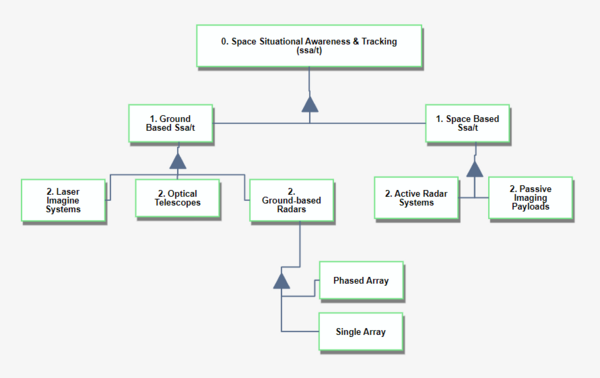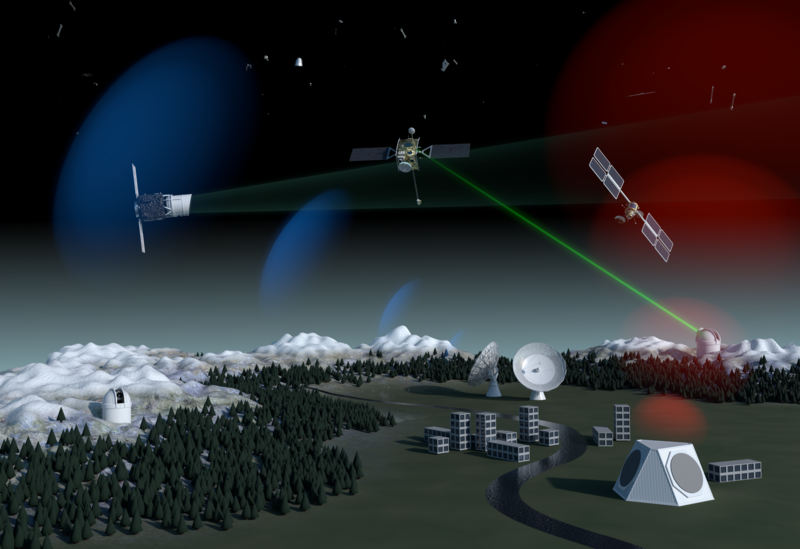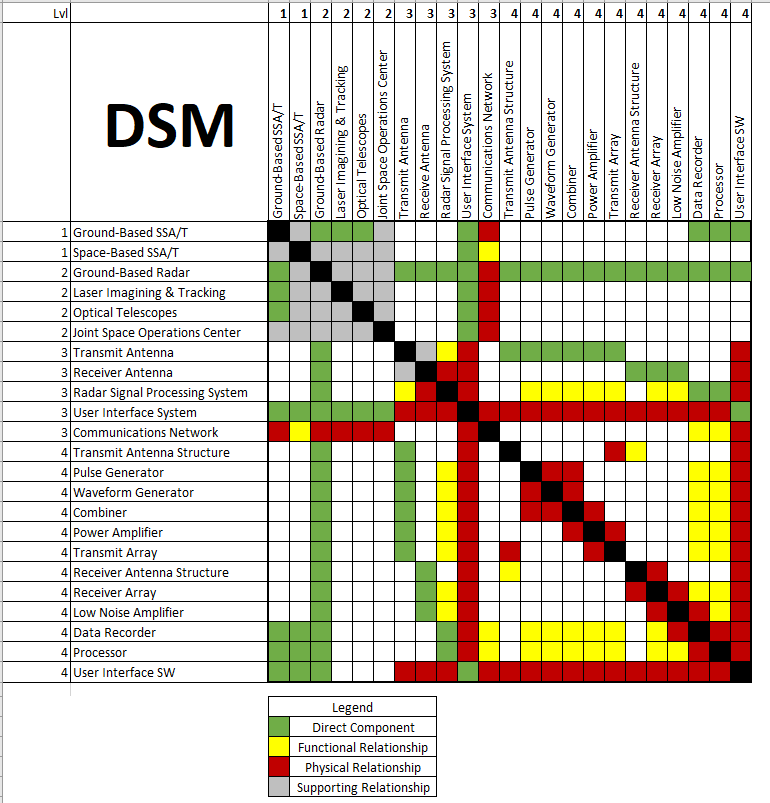Difference between revisions of "Ground Based Radar For Space Situational Awareness"
| Line 14: | Line 14: | ||
[[File:Level_Determination.png|600px]] | [[File:Level_Determination.png|600px]] | ||
''Ground Based Radar For Space Situational Awareness and the SSA/T Enterprise'' | ''Ground Based Radar For Space Situational Awareness and the SSA/T Enterprise'' | ||
Many systems comprise the architecture, each with its own technological challenges, advantages, and disadvantages. | |||
| Line 24: | Line 24: | ||
==Design Structure Matrix (DSM) Allocation== | ==Design Structure Matrix (DSM) Allocation== | ||
The DSM below provides a NxN mapping of the technologies within the SSA/T Enterprise, as decomposed initially in the SSA/T Enterprise figure above. The DSM describes the relationship between elements within the matrix as a component relationship (green), functional relationship (yellow), physically connected (red), or supporting relationship (grey). | |||
[[File:Draft_DSM_for_2GREAT.png|800px]] | |||
A component relationship is when one element is a component of the other. For example, the Radar Antenna has many components, such as the antenna array and the physical antenna structure. | |||
A functional relationship is when one element does not physically connect to another but fulfills a function together. For example, the Radar Signal Processing System relies on information from the User Interface on the Pulse Generator. | |||
A physical relationship is when one element is physically connected to another. An example is the Joint Space Operations Center's connection to a communication network that is not necessarily physically connected to the ground-based radar system. | |||
Lastly, a supporting relationship is when one element provides support to the other that is not functional or physical. For example, Space-based and Ground-based systems may coordinate to support the orbit determination of a piece of space debris. | |||
Revision as of 22:41, 1 October 2023
Technology Roadmap Sections and Deliverables
This technology roadmap is identified as:
- 2GREAT - Ground Based Radar For Space Situational Awareness
Or as Ground-based Radar to Enable Awareness and Tracking (GREAT)
Space Situational Awareness and Tracking (SSA/T) is the operational concept to detect, identify, and track Resident Space Objects (RSOs), orbiting around the Earth. The SSA/T enterprise is comprised of ground-based and space-based sensors with a broad customer base. SSA/T originated from the need to track RSOs in orbit to support data analysis and collision avoidance of active satellite vehicles (SVs), inactive SVs, and orbital debris. As of 1 September 2023, the European Space Agency estimates about 8600 functioning SVs, over 1,036,500 objects greater than 1cm, and more than 11,000 tonnes of mass in orbit1.
The figure below illustrates the levels within the SSA/T enterprise.
 Ground Based Radar For Space Situational Awareness and the SSA/T Enterprise
Many systems comprise the architecture, each with its own technological challenges, advantages, and disadvantages.
Ground Based Radar For Space Situational Awareness and the SSA/T Enterprise
Many systems comprise the architecture, each with its own technological challenges, advantages, and disadvantages.
Roadmap Overview
Artist's impression of various SSA systems comprising a full SSA architecture.<ref>“Space Surveillance and Tracking - SST Segment.” Accessed October 1, 2023. https://www.esa.int/Safety_Security/Space_Surveillance_and_Tracking_-_SST_Segment. </ref>
Design Structure Matrix (DSM) Allocation
The DSM below provides a NxN mapping of the technologies within the SSA/T Enterprise, as decomposed initially in the SSA/T Enterprise figure above. The DSM describes the relationship between elements within the matrix as a component relationship (green), functional relationship (yellow), physically connected (red), or supporting relationship (grey).
A component relationship is when one element is a component of the other. For example, the Radar Antenna has many components, such as the antenna array and the physical antenna structure.
A functional relationship is when one element does not physically connect to another but fulfills a function together. For example, the Radar Signal Processing System relies on information from the User Interface on the Pulse Generator.
A physical relationship is when one element is physically connected to another. An example is the Joint Space Operations Center's connection to a communication network that is not necessarily physically connected to the ground-based radar system.
Lastly, a supporting relationship is when one element provides support to the other that is not functional or physical. For example, Space-based and Ground-based systems may coordinate to support the orbit determination of a piece of space debris.
Roadmap Model using OPM
Figures of Merit
Alignment with Company Strategic Drivers
Positioning of Company vs. Competition
Technical Model
Financial Model
List of Demonstrator Projects
Key Publications, Presentations and Patents
Technology Strategy Statement
References
[1] European Space Agency, Space Environment Statistics, Accessed 1 October 2023 <ref> https://www.esa.int/Space_Safety/Space_Debris/About_space_debris#:~:text=In%20more%20than%2060%20years,10%20cm%20in%20low%2DEarth <ref>

